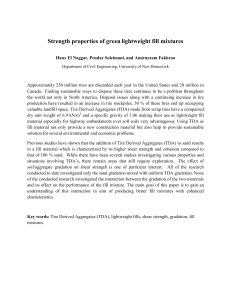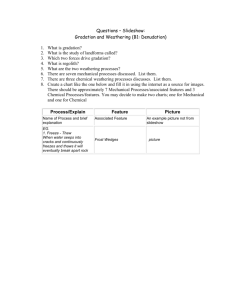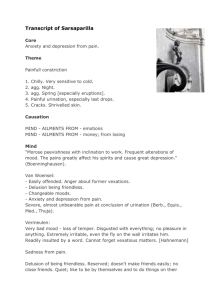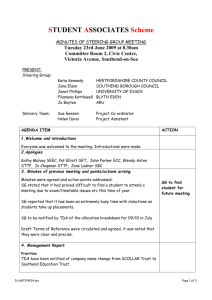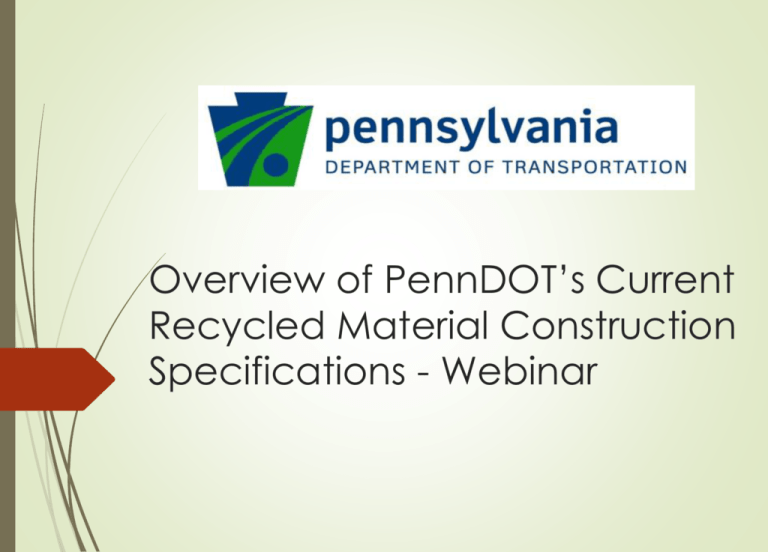
Overview of PennDOT’s Current
Recycled Material Construction
Specifications - Webinar
Administrative Items
Handouts
Background Noise
Sign-in / Course
Evaluations
Questions
Overview
The following information will be
provided for each recycled material.
General Information
Construction Specifications
Gradation Requirements
Quality Requirements
Material Limitations
Material source availability, approval,
and relative costs
Reclaimed Portland Cement
Concrete (RPCC) - General
Information
Generated from crushing concrete elements.
Sources: concrete pavement, construction and
demolition debris.
Can be from mixed sources if supplier
demonstrates that materials meet gradation
and quality requirements
Must be free of exposed metal reinforcement or
mesh.
Specific gravities in 2.2 to 2.5 range.
RPCC – General Information
RPCC – General Information
Must meet PennDOT’s Environmental Due
Diligence requirements for Clean Fill.
Must comply with all applicable requirements
governing clean fill use / placement to be
protective of Commonwealth waters:
25 Pa. Chapter 93 – Water Quality Standards
25 Pa. Chapter 102 – Erosion and Sediment
Control
25 Pa. Chapter 105 – Dam Safety and
Waterway Management
RPCC - Construction
Specifications
RPCC for Miscellaneous Drainage
Special Provision (SP), Item 9613-0001
RPCC for Rock Lining
Special Provision (SP), Item 9626-XXXX
RPCC for Gabions
Special Provision (SP), Item 9850-XXXX
RPCC – Gradation Requirements
Miscellaneous Drainage (Item 9613-0001): Pub.
408 - Section 613.2, and; Section 703.2 (Coarse
Aggregate - AGG), Table B, Type C.
AGG or AGG blends [min. 50% RPCC] in
proportions with conventional AGG to meet
gradation requirements, providing all RPCC
AGG or blends are retained on No. 4 sieve.
AASHTO No. 1 and No. 57 gradation
requirements.
No fines (minus No. 4) allowed for this
application.
RPCC – Gradation Requirements
Rock Lining (Item 9626-XXXX): Meets
requirements of Pub. 408 - Section 850.2 and;
AGG or AGG blends [min. 50% RPCC] in
proportions with conventional AGG to meet
gradation requirements, with a min. specific
gravity of 2.5, determined by AASHTO T85,
bulk saturated, surface dry basis.
RPCC AGG R-3, R-4, and R-5 rock size
classifications.
If blended with conventional AGG, can meet
R-3 through R-8 rock size classifications.
RPCC – Gradation Requirements
Gabions (Item 9850-XXXX: Type A and B): Meet
requirements of Pub. 408 - Section 626.2
(exclude Section 626(c)1) and;
Provide AGG or AGG blends [min. 30%
RPCC] with conventional AGG in
proportions to meet gradation
requirements.
RPCC can be produced
to meet the Type A and
Type B, 3-5 inch and 4-8
inch size requirements.
RPCC – Quality Requirements
Supplier submits samples to Lab. Testing Section
for petrographic examination for durability
before use.
Freeze-thaw testing (ASTM D 5312) with
following modifications:
1. Oven dry samples at 60 ± 3ºC (140 ± 5 ºF).
2. Run 50 freeze-thaw cycles on samples.
3. Largest remaining portion of each sample is
passing portion, and remaining smaller
portions are failing portions.
Largest allowable loss for any individual sample
and average loss for all the samples, 5.0%
Gabions / 20.0% Rock Lining and Misc. Drainage
RPCC – Quality Requirements
Less than 5 % by mass of foreign materials.
High alkalinity can produce leachate with pH
values in 5 to 10 range (remnant mortar).
Leachate pH diminishes with time,
conventional AGG and coarse RPCC AGG
blends, will proportionally diminish pH leachate
impacts.
Fines (minus No. 4) contribute to higher
precipitate levels from leaching of calcium
based compounds.
All RPCC AGG are capable of producing
various amounts of precipitate.
RPCC – Limitations
DO NOT USE - for Miscellaneous Drainage:
Drainage applications with perforated drainage
pipes or where water moving through RPCC may
enter perforated pipe
Unless District directed RPCC blend, high
permeability geotextile, or drain pipes with
higher initial drainage permeability alternate
design.
Drainage backfill for aluminum, galvanized steel
pipes, or other non-corrosion resistant incidental
construction items.
In direct contact with perennial streams, 300 feet of
Exceptional Value (EV) or High Quality (HQ) waters
without prior PADEP approval.
RPCC – Limitations
DO NOT USE - for Rock Lining
Applications with direct contact with
aluminum or galvanized steel pipes to
minimize potential corrosion of pipes from
higher pH leachate.
In direct contact with perennial streams,
300 feet of Exceptional Value (EV) or high
quality (HQ) waters without prior approval
from PADEP.
RPCC – Limitations
DO NOT USE - for Gabions
In direct contact with perennial
streams, 300 feet of Exceptional Value
(EV) or High Quality (HQ) waters
without prior approval from PADEP.
Use corrosion resistant gabions
RPCC - Advantages
Project cost savings realized by
reducing concrete transportation and
disposal costs.
Reduce virgin material quantities and
transportation costs.
Mobile equipment (i.e., crushers,
screens, etc.) is available and can be
brought to the project site.
RPCC –Source Identification
and Approval
Publication 34 – AGG Producers – Bulletin 14.
Others sources: must demonstrate that they meet
Special Provision quality and gradation
requirements.
Certified laboratory test data on source
material.
For AGG produced from controlled source,
quality tests performed within the last year.
For AGG produced from mixed sources,
quality and gradation testing specified by
District based on project requirements.
Tire Derived Aggregate
(TDA)
TDA – General Information
Lightweight embankment fill
Compacted TDA weighs significantly less than
ordinary soils (50 lbs/ft3 versus 120 lbs/ft3)
High hydraulic conductivity (1 to 10 cm/s)
Low earth pressures
Can cost 50% less than conventional lightweight
fill materials (expanded shale, geofoam)
May eliminate need for staged construction
due to reduced overburden pressures
TDA - Construction
Specifications
Select Borrow Excavation, Structure
Backfill, Tire Derived Aggregate
Special Provision (SP) , Item 9203-0100
Production of Tire Derived Aggregate for
Embankments and Backfills
Special Provision (SP), Item 9703-0100
TDA Gradation Requirements
Length: No more than 1% &10% (by weight); max.
dimension > than 18” & 12”, respectively.
Exposed Metal: At least 76% and 90% (by weight)
of tire shreds with metal fragments encased in
rubber that do not protrude > 1” & 2” from edge of
tire shreds.
Free Steel: Less than 1% by weight of metal
fragments.
Deleterious Materials: oils, gasoline, diesel fuel,
hydraulic fluid, grease, ice, snow, burnt tires.
Gradation:
Sieve Size
8”
3”
1.5”
No. 4
% Passing
75-100%
50% max.
25% max.
1% max.
TDA - Embankment Design
Requirements
Item Specification 9203-0100
Core of TDA, encapsulated on all
sides,
Separation geotextile and soil on all
sides, and
TDA is compressible and requires
overbuilding top of each TDA layer.
Embankment Design Single Shred Layer
Core of tire shreds encapsulated by soil on all sides
with bottom drainage
CL
SURCHARGE
PENNDOT CLASS 4
GEOTEXTILE WRAP ON
TIRE SHRED LAYER
2
4.5' MIN.
1
SIDES SLOPES 12' WIDE
(TYPICAL)
HIGH STRENGTH
GEOTEXTILE
10' MAX.
3% SLOPE
DRAINAGE TRENCH
1' THICK (TYPICAL)
FOR DETAILS
SEE FIGURE 3
Embankment Design Dual Shred Layer
Same as single layer system, but with interlayer of
soil
CL
SURCHARGE
2
1
4.5' MIN.
PENNDOT CLASS 4
GEOTEXTILE WRAP ON
TIRE SHRED LAYERS
(TYPICAL)
10' MAX.
3% SLOPE
3' MIN.
DRAINAGE TRENCH
1' THICK (TYPICAL)
SIDES SLOPES 12' WIDE
(TYPICAL)
10' MAX.
HIGH STRENGTH
GEOTEXTILE
3% SLOPE
FOR DETAILS
SEE FIGURE 3
TDA Embankment Typical Design
Values
100 tires = 1 ton = 1.5 yd3.
Compacted unit weight - 50 lb/ft3.
Compacted dry unit weight – 50 lb/ft3.
Internal angle of friction (ϕ’) - 27° (toe failure)
Internal angle of friction (ϕ’) - 25° (deep
seated)
Cohesion Intercept (c’) - 70 lb/ft2 (toe failure)
Cohesion Intercept (c’) - 0 lb/ft2 (deep seated)
Active pressure coefficient against abutment
(Ka) – 0.3
TDA Production for Embankments and
Backfills - Item Specification 9703-0100
PennDOT-approved TDA requires process, not
single machine, same way as approved
aggregates require crushing, screening,
washing, quality control, etc.
TDA Production – Process Flow Diagram
TDA-Quality Assurance Testing
Gilson vibratory shaker
model (TS-1) with 8”,
3”, 1.5” sieves and
pan.
Clockwise from top left –
material retained on 12”,
8”, and 3” sieve (middle
bucket), bottom left 1.5” sieve, and bottom
right ¾” sieve respectively.
Non-Specification TDA
Length, free, exposed steel
Approved TDA
Clean cuts most
desirable outcome
Most pieces < 12 inches
TDA-Material Availability and
Source Identification
Abandoned waste tire pile cleanups
Roughly 925K tires (9,250 tons) in waste
tire piles throughout Commonwealth
(1/4/2013)
River sweeps
Community cleanups
PennDOT SEMP Section and the PADEP can
assist in identifying scrap tire sources as
recycling of tires will likely involve
coordinated effort.
TDA-Considerations and
Limitations
For Embankment Construction
Do not place on frozen ground, and
Min. of 2 feet above seasonal high water
table and 100 year flood plain level
Placement is critical to avoid foreign
material contamination by construction
equipment
TDA-Considerations and
Limitations
For TDA Production
Must hold a Beneficial Use Permit, PADEP
General Permit No. WMGR038, and
Large area required for scrap tire
stockpiling and approved TDA staging
before placement.
Crumb Rubber Modifier
(CRM) as Stabilizer
CRM – General Information
Construction Specification Section 419 –
Stone Matrix Asphalt Mixture Design,
Restricted Performance Specification
(RPS) Construction of Plant-Mixed HMA
wearing courses was recently revised to
include Crumb Rubber Modifier as
Stabilizer.
Reflected in Publication 408/2011
(change No. 4 / effective April 5, 2013).
CRM – Construction Specification
419.1 Description—This work is the RPS
construction of plant-mixed Stone Matrix
Asphalt (SMA), on a prepared surface
using a volumetric mixture design
developed with the Superpave Gyratory
Compactor.
CRM – Construction Specification
Section 419.2(d) – Stabilizer: Provide
mineral fiber, cellulose fiber, or crumb
rubber (CR) stabilizers conforming to the
requirements below and added at a rate
specified in Table B. Use the dosage rate
prescribed in the job mix formula.
Crumb Rubber: Use CR derived from
processing of recycled tires. Rubber tire
buffings from retreading qualify as a
source of CR. Furnish processed, free
flowing CR from a manufacturer listed in
Bulletin 15, certified as specified in Section
106.03(b)3.
CRM – Gradation Requirements
5.a Gradation: Meet the following
gradation as determined according to
ASTM D 5461 using 200 mm diameter sieves
and maintaining a maximum allowable
loss after sieve analysis of 7.65%. As an
alternative dry sieve analysis test method,
perform sieve analysis of CR according to
Florida Test Method, FM 5-559.
CR Gradation Sieve Size
4.75 mm (No. 4)
2.36 mm (No. 8)
75 μm (No. 200)
Percent Passing
100
98-100
0-3
CRM – Quality Requirements
5.b Contaminants. CR must be relatively
free from fabric, wire, cord, and other
contaminating materials to a maximum
total contaminant content of 2.5%
Max. of 1.0% iron
Max. of 1.0% fiber
Max. of 0.5% other contaminants
Determined by weight of total CR sample
components.
CRM – Quality Requirements
Remove rubber particles from fiber balls
before weighing.
Determine metal content by thoroughly
passing a magnet through a 50 + g (1.76 +
0.004 ounces) sample.
Determine fiber content by weighing fiber
balls, which are formed during gradation
test procedure.
Project Opportunities
Potential Materials
Reclaimed Portland Cement
Concrete (RPCC) – Misc. Drainage,
Gabions and Rip-rap
Tire Derived Aggregate (TDA) Embankment Material
Crumb Rubber – CRM as Stabilizer –
HMA Mix
Compost – E&S Controls
Crushed Glass – Embankment Material
Spent Foundry Sand – Aggregate and
Flowable Fill
http://www.dot.state.pa.us/
PennDOT’s
Strategic
Recycling Program
(SRP) Webpage
44
Copyright © 2013 by the Commonwealth of Pennsylvania. All rights reserved. No part of this publication may be
reproduced, stored in a retrieval system, or transmitted in any form or by any means electronic, mechanical,
photocopying, recording or otherwise without prior written permission by PennDOT.
This training course was developed in partnership with the Pennsylvania Department of Transportation’s Business
Leadership and Administrative Services Office and the Bureau of Maintenance and Operations and Apex
Companies, LLC. It is offered as part of the Pennsylvania Department of Transportation’s Highway Administration
Comprehensive Training Plan exclusively through the Technical Training and Development Section.
.

